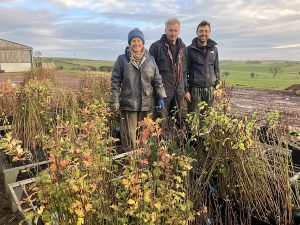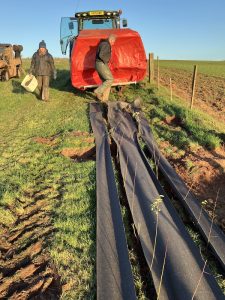ONLINE ORDERS: Please place by SUNDAY midnight for delivery to all postcodes the following FRIDAY other than HIGHLANDS & ISLANDS. In which case please phone for advice & order as early as possible to allow for early courier collection. For more information on delivery & post codes , please check here
FREE LOCAL DELIVERIES FOR POST CODES TD11-TD15
Menu
Menu

 We had some wonderful hard-core volunteers who helped us put in the hours. The hedge planter was modified to also roll the biodegradable weed suppressing mulch as we planted (which didn’t like windy days !). The mulch suppresses the weeds sufficiently to enable the hedgerow plants to start their growth without being completely covered by grass.
Rows have required fencing to protect from cattle, roe deer, hare and rabbit browsing with netting and where we were unable to fence both sides we have used biodegradable tree-shelters.
We had some wonderful hard-core volunteers who helped us put in the hours. The hedge planter was modified to also roll the biodegradable weed suppressing mulch as we planted (which didn’t like windy days !). The mulch suppresses the weeds sufficiently to enable the hedgerow plants to start their growth without being completely covered by grass.
Rows have required fencing to protect from cattle, roe deer, hare and rabbit browsing with netting and where we were unable to fence both sides we have used biodegradable tree-shelters.
 short-rotation system and will provide options for future enterprises. The new hedgerow-thicket matrix provides wide interconnecting rows with verges full of grasses and flowers for pollinators and seed eating birds. As the roots grow and penetrate deeper into the soil they will bind the soil and enhance soil biodiversity and draw-down carbon.
short-rotation system and will provide options for future enterprises. The new hedgerow-thicket matrix provides wide interconnecting rows with verges full of grasses and flowers for pollinators and seed eating birds. As the roots grow and penetrate deeper into the soil they will bind the soil and enhance soil biodiversity and draw-down carbon.




